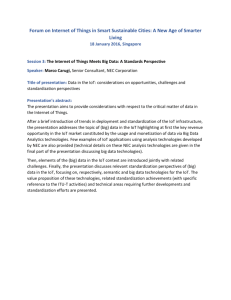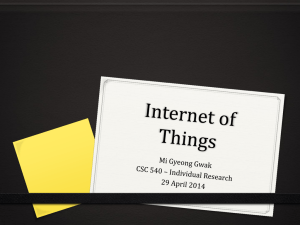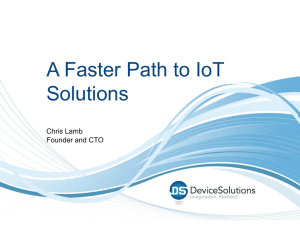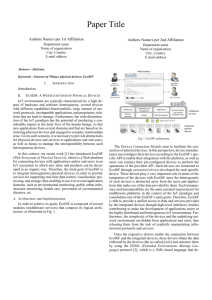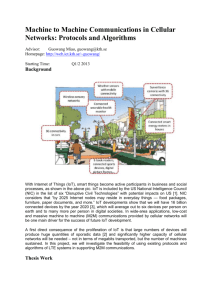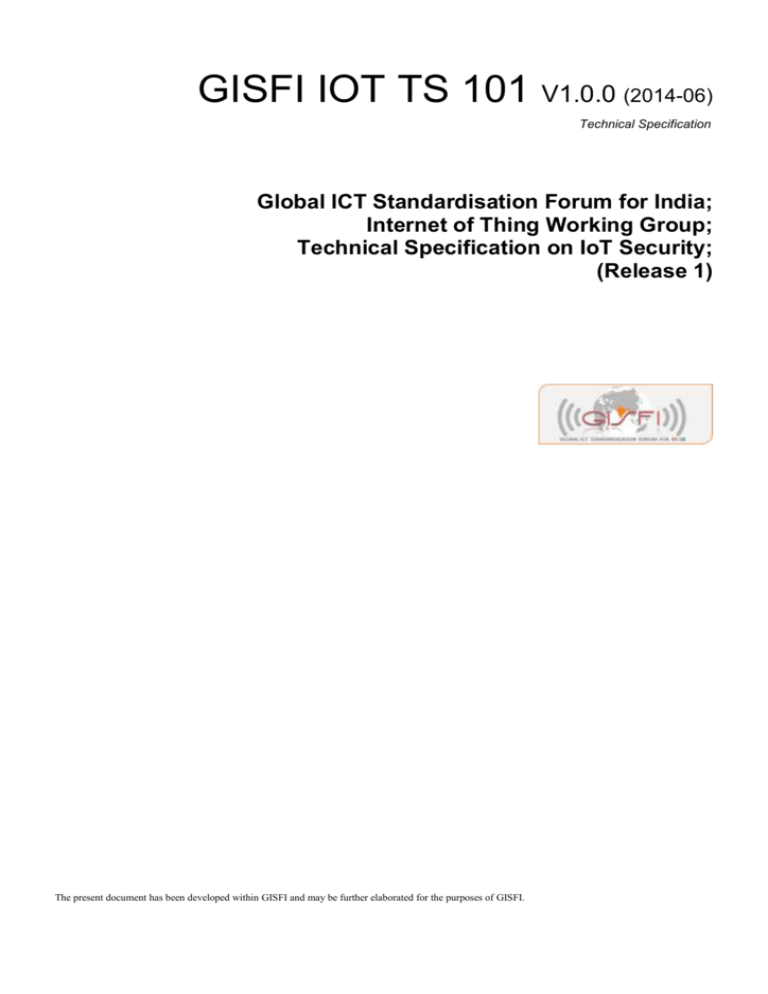
GISFI IOT TS 101 V1.0.0 (2014-06)
Technical Specification
Global ICT Standardisation Forum for India;
Internet of Thing Working Group;
Technical Specification on IoT Security;
(Release 1)
The present document has been developed within GISFI and may be further elaborated for the purposes of GISFI.
Release 1
2
GISFI IOT TS 101 V1.0.0 (2014-06)
Keywords
<keyword[, keyword]>
GISFI
Postal address
GISFI office address
Address
Tel.: +91 xxxxxxx Fax: +91 xxxxxx
Internet
http://www.gisfi.org
Copyright Notification
No part may be reproduced except as authorized by written permission.
The copyright and the foregoing restriction extend to reproduction in all media.
© 2014, GISFI
All rights reserved.
GISFI
Release 1
3
GISFI IOT TS 101 V1.0.0 (2014-06)
Contents
Foreword............................................................................................................................................................. 4
Introduction ........................................................................................................................................................ 4
1
Scope ........................................................................................................................................................ 5
2
References ................................................................................................................................................ 5
2.1
2.2
3
3.1
3.2
4
Normative references ......................................................................................................................................... 5
Informative references ....................................................................................................................................... 5
Definitions, symbols and abbreviations ................................................................................................... 6
Definitions ......................................................................................................................................................... 6
Abbreviations ..................................................................................................................................................... 6
Lightweight Internet of Things Platform.................................................................................................. 7
4.1
General Security Requirements ............................................................................................................................... 7
4.2
Authentication Requirements.................................................................................................................................. 7
4.3
Access Control Requirements ................................................................................................................................ 8
4.4
Secure Communication of Devices in IoT ......................................................................................................... 8
4.4.1
Communication Security .............................................................................................................................. 8
4.4.2
Storage Security ........................................................................................................................................... 9
4.4.3
IoT Device Management Security ................................................................................................................ 9
4.4.4
IoT service platform security ....................................................................................................................... 9
5.
5.1
5.1.1
5.1.2
5.1.2.1
5.1.2.2
5.1.2.3
5.1.2.4
5.1.2.4
5.1.2.5
5.1.3
6.
6.1
6.2
7.
7.1
7.2
7.3
7.4
7.5
Option1: IBE Scheme for secure IoT communication ........................................................................... 10
IoT secure communication protocol ................................................................................................................ 10
Sensor/Device/Application Registration .................................................................................................... 10
IoT Secure communication Protocols ........................................................................................................ 11
One way Device to Application communication through gateway ...................................................... 11
Two way Device to Application communication through gateway ...................................................... 11
Two way Device to device communication through gateway .............................................................. 12
Two way Device to device communication without Gateway ............................................................. 12
Group Communication ......................................................................................................................... 12
Key Revocation .................................................................................................................................... 13
IoT secure communication protocol APIs .................................................................................................. 13
Option 2: Lightweight Security: IoT-Sec-Lite ....................................................................................... 15
CoAP specific implementation ........................................................................................................................ 16
The 4-way handshake ...................................................................................................................................... 16
Option 3: Communication Security in IoT protocols ............................................................................. 18
Communication Security in UPnP ................................................................................................................... 18
Communication Security in DPWS ................................................................................................................. 18
Communication Security in CoAP ................................................................................................................... 18
Comparison of IoT Device Specific Protocols Security aspects ...................................................................... 19
Recommended device specific protocol. ......................................................................................................... 20
Annex <A>: <Annex title> ............................................................................................................................. 21
A.1
Heading levels in an annex..................................................................................................................... 21
Annex <X>: Change history .......................................................................................................................... 22
GISFI
Release 1
4
GISFI IOT TS 101 V1.0.0 (2014-06)
Foreword
This Technical Report has been produced by GISFI.
The contents of the present document are subject to continuing work within the Internet of Thing Working Group and
may change following formal IoT WG approval. Should the IoT WG modify the contents of the present document, it
will be re-released by the IoT WG with an identifying change of release date and an increase in version number as
follows:
Version x.y.z
where:
x the first digit:
1 presented to TWG for information;
2 presented to TWG for approval;
3 or greater indicates TWG approved document under change control.
y the second digit is incremented for all changes of substance, i.e. technical enhancements, corrections,
updates, etc.
z the third digit is incremented when editorial only changes have been incorporated in the document.
Introduction
The main concern of IoT system is to interact with larger number of resource constrained devices like many tiny
sensors. These sensing devices produce a vast amount of sensitive data like location information, health records etc.
Therefore security and privacy are major concerns.
To address the security issue IoT system should not use any resource greedy mechanism for exchanging
information with these tiny sensors. Security mechanism should be low overhead, scalable, supports mutual
authentication.
The present document discusses general security requirement, authentication as well as access control requirement
and low overhead security mechanism for IoT application protocols. It describes the mapping of the proposed low
overhead security mechanism across the interfaces of the IoT framework architecture.
GISFI
Release 1
1
5
GISFI IOT TS 101 V1.0.0 (2014-06)
Scope
This document covers IoT Security specification which includes Security requirement from different aspects IoT
systems such as General Security Requirements, Authentication Requirements, Access Control Requirements,
communication security requirement and storage security requirements and the solutions which meet the above
mentioned security requirements.
2
References
2.1
Normative references
The following referenced documents are indispensable for the application of the present document. For dated
references, only the edition cited applies. For non-specific references, the latest edition of the referenced document
(including any amendments) applies.
[1].
[2].
[3]
[4].
[5].
[6]
[7]
[8]
[9]
[10]
[11]
Technical Report on IoT Reference Architecture (Draft - GISFI_IoT_201203175)
Technical Report on Naming and Addressing in IoT(Draft-GISFI_IoT_201209 292)
Frame-work document for Technical Report on IoT Service Requirements (Draft GISFI_IoT_201106103)
http://www.scribd.com/doc/81784648/ETSI-TS-102-690-v-1-1-2-2011
http://tools.ietf.org/html/rfc3986
http://www.ietf.org/rfc/rfc2396.txt
http://tools.ietf.org/html/draft-shelby-core-resource-directory-04
IoT System Architecture (Draft-GISFI_IoT_201109135)
Architecture document for Technical Report on IoT Service Requirements (Draft-GISFI_IoT_201112140)
IoT Application Use Cases (Draft-GISFI_IoT_201112141)
Ukil, Arijit. Bandyopadhyay, Soma. Bhattacharyya, Abhijan. and Pal, Arpan. Lightweight Security
Scheme for Vehicle Tracking System Using CoAP. In Proc. ASPI , UBICOMP -2013
[12] L. Seitz,et al.”Use cases for CoRE security,” IETDF draft-seitz-core-sec-usecases-00,September, 2013
[13]. IoT Application Use Cases (Draft-GISFI_IoT_201112141)
2.2
Informative references
The following referenced documents are not essential to the use of the GISFI deliverable but they assist the user
with regard to a particular subject area. For non-specific references, the latest version of the referenced document
(including any amendments) applies.
[1].
[2]
[3]
[4]
[5]
[6]
[7].
ITU-T Study Group -2 document on National Numbering Plan (Docs related to ITU-T E.164)
Draft TISPAN MI [00058] V0.0.11 (2011-03), ETSI TISPAN Future Topics, March 2011
IoT Activity (Draft-GISFI_IoT_201112137)
IoT Architecture (Draft-GISFI_IoT_201112138)
GISFI IoT Architecture Comparison (Draft-GISFI_IoT_201112139)
Base line requirement GISFI_IoT_201212343.doc
IoT Activity (Draft-GISFI_IoT_201112137)
GISFI
Release 1
6
GISFI IOT TS 101 V1.0.0 (2014-06)
3
Definitions, symbols and abbreviations
3.1
Definitions
For the purposes of the present document, the following terms and definitions apply:
IoTSystem:IoT is an integrated part of the future Internet that could be defined as “a dynamic global network
infrastructure with self-configuring capabilities linking physical and virtual objects through the exploitation of data
capture and standard and inter-operable communication protocols”.
IoT Device: Entity capable of sensing the state/features of an object and has communication and computing
capability. It may run limited local applications. The IoT device connects to the IoT Core network either through a
gateway or directly through embedded gateway functionality.
IoT Limited Device:It is an IoT device without capability of local computing (applications). It can communicate to
another IoT device or gateway. From the IoT perspective, it is managed by the IoT device/gateway to which it
connected.
IoT Gateway: IoTGateway acts as a proxy between the IoT devices and IoT Core network. It shall locally manage
the IoT devices (including IoT Limited Devices) andshall run IoT applications.
IoT Network: IoT Network includes the access network that connects the IoT devices to the gateway and core
network that connects the gateways to the IoT service platforms.
IoT Service Platform: It provides an open interface to IoT functions that can be shared by multiple applications. It
hides the intricacies of underlying IoT system and eases the application development. Further various system
management and control functions are also taken care here.
IoT Applications: IoT applications are domain specific applications that use various services exposed by IoT
Service Platform.
3.2
Abbreviations
For the purposes of the present document, the following abbreviations apply:
AES
ARP
ETSI
DTLS
IBE
ID
IoT
IP
M2M
NONCE
PKI
RFID
SLA
TCP
URI
Advanced Encryption Standard
Address Resolution Protocol
European Telecommunications Standards Institute
Datagram transport layer security
Identity based Encryption
Identity
Internet of Things
Internet Protocol
Machine to Machine
Number or bit string used only once, in security engineering
Public Key Infrastructure
Radio Frequency ID
Service-Level agreement
Transmission Control Protocol
Uniform Resource Identifier
GISFI
Release 1
4
7
GISFI IOT TS 101 V1.0.0 (2014-06)
Lightweight Internet of Things Platform
This document presents requirements of lightweight architecture for Internet of Things (IoT).It discusses the
mapping of these requirements with the functional architecture of the IoT stack as given in IoT reference
architecture [1].
The scope of the IoT architecture is from sensors/devices to applications. The IoT stack is expected to capture the
heterogeneity of devices and communication protocols at the lower layer and to provide uniform interfaces to the
upper layers.
Objectives of formulating the requirements of lightweight nature of IoT system are multifold and are explained as
follows:
a) It identifies major reference points / interface points which demands lightweight architectural functionalities can
be considered for standardization to encourage interoperability of products and services from multiple stake
holders.
b) It helps in explaining various IoT use case scenarios and gathering respective requirements of these interfaces in
terms of lightweight characteristics.
c) Developing consistency in information exchange and contributions from multiple participants of this standards
development effort
4.1
General Security Requirements
Current section of this document describes the general security requirement, authentication and access control
requirements based on [11]. After that it describes a low – overhead security mechanism based on a low-overhead
application protocol.
Ensuring integrity, confidentiality and replay protection of the message exchanges that take place among the
Resource Server, the Client and other involved third parties.
Protection of the Resource Server from denial of service attacks, and minimizing the number of steps of the
protocol that an attacker can cause the server to perform without proper authentication and authorization.
The security measures applied must work even when the traffic from the Client to the Resource Server to go
through intermediate nodes such as gateways, proxies, firewalls etc.
Minimal resource should be used for employing the security measures, like minimizing the battery usage,
message exchanges for security, size of authentication and authorization data that is transmitted, size of
required software libraries, memory and stack usage on the devices.
The protocols for constrained nodes should require secure modes of use by default, because end users rarely tend
to change the default settings of their devices.
The security mechanisms should allow interoperability, which means resource owners should be allowed to
interact with clients from different manufacturers and vice-versa.
The security mechanisms should not hamper its usability, which means response times should be kept
reasonable, security measures should be made transparent for human users where possible, and the
administration of security should be as simple as possible.
4.2
Authentication Requirements
Mutual authentication between the client and the resource server.
Provision of authentication means to clients and resource server.
Remote revocation of authentication means should be enabled.
GISFI
Release 1
4.3
8
GISFI IOT TS 101 V1.0.0 (2014-06)
Access Control Requirements
The access control policies set by the Resource Owner needs to be provisioned to the Policy Decision Point, which
could be the Resource Server or another trusted entity, and needs to be applied to the incoming request.
Additional messages should not be sent just for access control.
Different rights should be applied to different requesting entities.
Fine-grained access control should be allowed, because Resource Servers can host several resources, and
resources can have different settings.
Policy updates should be updated without the need for re-provisioning, because client may change frequently,
making provisioning much expensive.
The Policy Decision Point must be able to take local conditions, such as access to data in case of emergencies,
into account.
4.4
Secure Communication of Devices in IoT
As discussed in the IoT reference architecture [1], the actors in IoT are devices, gateways and external applications/
devices. They communicate each other to improve the user experiences in real time (Example: disaster management
using IoT). Most of the time, the communication will be through wireless medium. Thus it brings the very critical issue,
the data/communication security, which is in greater threat and the questions the integrity of the IoT. So one of the most
fundamental issues in IoT is how to Implement a secure communication between the devices and also authenticate the
devices.
For secure communication and authentication between the devices, cryptography is an essential tool. In general,
cryptography with PKI is very popular, wherein the certificates contains the public and private keys are issued to the
users and users using these keys encrypt and decrypt their data and thus security is enabled. The same scheme is not
suitable for IoT scenario. The crypto system for IoT security has following requirements. The requirements are broadly
classified into two categories to ensure Confidentiality, Integrity and Availability.
1. Communication Security
2. Storage Security
4.4.1
Communication Security
The communication security deals to handle the security for the IoT communications. It has following requirements
1.
Secure Device to Device Communication: Here the cryptographic technique should enable secure IoT
communication across l1, l2 and l3 interfaces. The cryptographic technique should be lightweight.
2.
No Public Key Infrastructure (PKI): Number of devices in IoT is very large, maintaining keys at PKI is not
feasible. So cryptographic technique with no PKI is very essential
3.
Certificate less cryptography: IoT demands less infrastructure for security, hence the requirement here is to
design crypto systems with no certificates.
4.
No Key Exchange: One of goal of IoT is to reduce number of control/communication messages. So this is
applicable to secure communications also. Since device to device communications in IoT are very prevalent,
to minimize the message overheads, crypto system should support no key exchanges.
5.
Anonymity: In IoT, prominently in the area of disaster management/mission critical operations, to avoid
attacks from the intruders, anonymity is required. So it is desirable that crypto system should support security
as well as anonymity also.
6.
Variable security requirement: Handling of heterogeneous devices with differing protocols
7.
Group Communication: In IoT, very often the Application(layer 4) requires data from different devices and
also need to control them
GISFI
Release 1
4.4.2
9
GISFI IOT TS 101 V1.0.0 (2014-06)
Storage Security
In future, IoT is the largest source of data for various diversified applications. How to store and archive the data at
devices, platform, and service providers robustly is a big challenge. So data should be delivered/distributed to
intended users/applications only in a secured and anonymized. So it is desirable to have a lightweight crypto system
for secure collection, storage, and archive and distribute.
So a scalable, lightweight, with no infrastructure, certificate less and no key exchange cryptographic technique is
essential for secure IoT communication. Thus using IBE, we can envisage the requirements of the secure
communication for IoT.
4.4.3
IoT Device Management Security
DS1. Devices should be authenticated.
DS2. Support for decoding encrypted data from sensor devices.
DS3. Support for low complexity security infrastructure.
4.4.4
IoT service platform security
SC1. Support of authenticating the application/service developer while installing the application or new services.
SC2. Support of secure channel establishment with IoT gateways as well as with application.
ISPC1. Support of transferring data with multiple service platform may or may not using low overhead path
ISPC2. Support of authentication & security
ISPC3. Support of preserving privacy
GISFI
Release 1
5.
10
GISFI IOT TS 101 V1.0.0 (2014-06)
Solution 1: IBE Scheme for secure IoT
communication
An IBE is a secure certificate-less cryptography scheme, wherein the devices can generate the public key of the
other devices by using publicly known identity of the devices such as device’s: id, owner’s id, mac-id, etc. and
encrypt the message with this public key and on the other hand the device which receives the encrypted message
shall decrypt the message using its’ private key (obtained during device registration/bootstrapping in IoT).
Thus the identities of the devices are very important aspect for the IBE scheme. Majority of the IoT devices have
unique identities such as device-id, URI, device’s network access id (NAI), Object Identifier OID (object-identifier
defines the domain the device belongs to + Data: unique for the given domain), The Internet Universal Resource
Name (URN: IETF RFC 1737). The URN name space includes ISSN,OID, ISBN, NBN, UUID, Nfc, Epc,
Epcglobal etc with namespace id (NID ) 3,4,9, 10,18,24,35, etc respectively. For example URN for a device/object
can be reference by urn:oid:ietf:xxxx.xxxx.xxxx. Similarly other way to given an identity to the device is using
ubiquitous code: ucode system which offers an end to end linking of objects to the IoT. The device number/id can be
obtained by registering to Ubiquitous ID center. Ucode is a 128 bit structure. Similarly DOI, URI and URL can also
be associated as an id to the device. We propose to use the device’s URI[2] as an Identity of the device along with
owner’s id
To perform secure IoT communication among the devices, they have to perform following operations
o
Setup: Public Key Generator (PKG) is established at Gateway [1].
o
Extract : Device Registers with its ID(Bootstrapping) with PKG(Gateway) and receives public and
private keys
o
Encrypt
o
Decrypt
In this section, we describe our proposed IBE scheme and IoT secure communication protocol.
5.1
IoT secure communication protocol
We propose following operations/APIs for IoT Secure communication protocol.
1. Sensor/Device/Application Registration(Layer1)
2. IoT Secure communication Protocols
3. Group Communication Protocols.
4. Key Revocation.
5.1.1
Sensor/Device/Application Registration
With reference to IoT architecture [1], the Public key Generator (PKG) shall be placed at Platform services, wherein it
facilitates the sensor/device/application registration and also provides their public keys and private keys on request.
Figure-1 describes the registration scheme under IoT framework. The sensor/device/Application submits their IDs
during registration and receives the ECC parameters required for the encryption and decryption. Table-1 describes the
list of ECC parameters that service platform transmits to the sensors/devices/applications.
GISFI
Release 1
5.1.2
11
GISFI IOT TS 101 V1.0.0 (2014-06)
IoT Secure communication Protocols
In IoT, the communications happens between the applications and the devices either to collect data from them or need
to send commands to control them. We envisage the following secure communications in IoT framework. For each of
the communication schemes, we propose to have separate IBE Protocol Interfaces (IPIs).
5.1.2.1
1.
One way Device to Application communication through gateway
2.
Two way Device to Application communication through gateway
3.
Two ways Device to Device Communication through Gateway.
4.
Two way Device to device communication without Gateway
5.
Group Communication
One way Device to Application communication through gateway
The scenario here is device1 wants to send a message to Application-1 through securely through gateway. The flow
is as follows (see Figure2).
1.
Device1 encrypts the message using Application1’s public id.
2.
Device1 encrypts the encrypted message+ Application1’s id using gateway’s public id.
3.
Device1 transmits the encrypted message done in step2 to gateway.
4.
Gateway upon receipt of the message decrypts the message using its’ private key
5.
Transmits the decrypted message to the Application1 using Application1’s address.
6.
Application1 decrypts the message using its private key.
The encryption in step 2 is required to annonmyze to the third part device that to whom the device1
sending the message. This scheme has added advantage that devie2 may not know, from whom it has
received the message. Thus sender’s identity is preserved and thus this scheme ensures sender’s
anonymity.
5.1.2.2
Two way Device to Application communication through gateway
The scenario here is device1 and Applicatiion1 wants to exchange the messages each other through securely through
gateway. The flow is as follows (see Figure3).
1.
Device1 encrypts the message+ device1’s id using Applicatiion1’s public id.
2.
Device1 encrypts the encrypted message+ Applicatiion1’s id using gateway’s public id.
3.
Device1 transmits the encrypted message done in step2 to gateway.
4.
Gateway upon receipt of the message decrypts the message using its’ private key
5.
Transmits the decrypted message to the Applicatiion1 using Applicatiion1’s address.
6.
Applicatiion1 decrypts the message+ device1s id using its private key
7.
Similarly the steps 1 to 6 are repeated with changing roles of device1 and Applicatiion1.
The encryption in step 2 and step 7 are required to annonmyze both the sender and receiver to the third
part device.
GISFI
Release 1
5.1.2.3
12
GISFI IOT TS 101 V1.0.0 (2014-06)
Two way Device to device communication through gateway
The scenario here is device1 and device2 wants to exchange the messages each other through securely through
gateway. The flow is as follows.
5.1.2.4
1.
Device1 encrypts the message+ device1’s id using device2’s public id.
2.
Device1 encrypts the encrypted message+device2’s id using gateway’s public id.
3.
Device1 transmits the encrypted message done in step2 to gateway.
4.
Gateway upon receipt of the message decrypts the message using its’ private key
5.
Transmits the decrypted message to the device 2 using device2’s address.
6.
Device2 decrypts the message+ device1s id using its private key
7.
Similarly the steps 1 to 6 are repeated with changing roles of device1 and device2.
Two way Device to device communication without Gateway
In this scenario two devices with in the same gateway cluster want’s to communicate each other securely without
gateway. This is done through mutual authentication. The flow is as follows.
5.1.2.4
1.
Device1 encrypts a secrete message (for example hello) + device1s id using device2’s public id.
2.
Device1 transmits/broadcasts the encrypted message.
3.
Among all the recipients, only device2 can decrypt the message using its’ private key.
4.
Device2 re-encrypt the decrypted message+ device2’s id using device1’s public key.
5.
Device2 transmits/broadcasts the encrypted message.
6.
Among all the recipients, only device1 can decrypt the message using its’ private key.
7.
Device1 verifies the message with its original message and if it is same then they start
communicating each other securely.
Group Communication
1. The set of devices and applications form a group.
2. The Application sends request to the service platform to generate group-id, group public key and group private
key.
3. The Application then transmits this information to the peer devices by encrypting individually with their public
ids.
4. The members of the group can decrypt any encrypted message, which is delivered to them using the group
private key and any device/Application which are not part of the group can send encrypted message using
group’s public key (generated from group public id).
GISFI
Release 1
13
GISFI IOT TS 101 V1.0.0 (2014-06)
Table-1: SendECCParameter Details
SendECCParameter
Sensor/Device/Application-ID-of-the Vehicle
Elliptic Curve=y2=ax3+bx2+c
Prime number :p
Prime Torsion group order q
Torsion group Point P=T[q]
Torsion group Point Q=S[q]
Public Key
Private Key
5.1.2.5
Key Revocation
How to re-issue the secrete key to the device again in case of key leakage to third party? This is called keyrevocation which is a difficult issue to resolve in case of IBE. We propose the use of attribute based encryption
scheme using lattice based cryptography.
5.1.3
IoT secure communication protocol APIs
We propose the following APIs for IoT secure communication protocols.
API
Interfaces
From
To
Through
I1/I2
Device(L1)
Service Platform(L3)
Gateway(L2)
doGWRegistration
I2
Gateway(l2)
Service Platform(L3)
-NA-
doApplicationRegistration
I3
Application(L4)
Service Platform(L3)
-NA-
sendECCParameters
I3/I2/I1/I4
Service
Platform(L3)
Device/Gateway/Application
Gateway/-
sendGW
I1
Device(L1)
Gateway(L2)
-NA-
I2/I3
Gateway(l2)/
Application(L4)
Service Platform(L3)
-NA-
I3
Service
Platform(L3)
Application(L4)
-NA-
I2
Service
Platform(L3)
Gateway
-NA-
deliverDevice
I1
Gateway(l2)/
Device(L1)
-NA-
doGroupRegistration
I3
Application(L4)
Service Platform(L3)
-NA-
doDeviceRegistration
SendSP
deliverApp
deliverGW
GISFI
Release 1
14
GISFI IOT TS 101 V1.0.0 (2014-06)
Figure-1 Sensor/Device/Application Registration at PKG
Figure-2 One way Device to Application communication through gateway
Figure-3 Two way Device to Application communication through gateway
GISFI
Release 1
6.
15
GISFI IOT TS 101 V1.0.0 (2014-06)
Solution 2: Lightweight Security: IoT-Sec-Lite
This section presents low overhead security scheme for IoT stated as one of the important requirements stated in
section 7 of Framework document for Technical Report on IoT Service Requirements document [2], and also stated
as device security requirements and IoT service platform’s security requirement in section 4 of base line
requirements document [10].
It presents authentication and key management based on symmetric key using AES 128 CBC (Cipher Block
Chaining) mode. Key management is integrated with authentication. This scheme uses a payload embedded
mechanism. “It consists of following phases:-1) secret distribution, 2) session initiation, 3) server challenge, 4)
sensor response”[7].
This scheme is efficient in comparison with any conventional PKI-based systems because of absence of any publickey crypto component. It eliminates hazards of complicated key management. It uses reduced number of
handshaking like two round trip process as compared to DTLS based scheme which has at least four round trips.
Also authentication on top of DTLS is not standardized yet.
This method is resistant w.r.t replay attack, meet in the middle attack, information disclosure attack. This NONCE
based authentication mechanism supports mutual authentication and at the end of authentication generates a session
key. This low-overhead secured mechanism is adapted on CoAP (constrained application protocol) an established
lightweight application protocol to achieve an end to end low-overhead secured channel.
Figure 1 below depicts the layering of CoAP running on DTLS, and Figure 2 depicts the layering of proposed
lightweight secured CoAP, here request-response and messages layers of CoAP are utilized to achieve ‘Auth-Lite’
the proposed low-overhead authentication and key management.
Figure1: Abstract layering of DTLS– CoAP
GISFI
Figure 2: Proposed Secured CoAP
Release 1
16
GISFI IOT TS 101 V1.0.0 (2014-06)
6.1 CoAP specific implementation
This section describes how the proposed scheme can be integrated with CoAP. The inherent reliable delivery helps
easy implementation of the proposed scheme against packet loss. Two options are introduced for POST method to
be used for authentication as described in Table 1 and 2.
Table 1. Option Properties
Table 2 Description of the options
6.2
The 4-way handshake
The 4-way handshake is described below:
At initiation, the client sends a POST message in CON mode to a server URI "/.well-known/authorize". The
'Auth' option is set to true. The 'Auth-Msg-Type' set as 'auth_init', and 'device identifier' in the payload.
'\authorize' is the resource at the server for initiating authorization activity.
The combination of Auth = True and Auth-Msg-Type = 'auth-init' indicates a session initiation to the server. The
server derives device identifier from the received payload and determines pre-shared secret associated with that
device-identifier. The server then generates 'nonce1' (server-nonce) and a Key (K). Server forms an encrypted
payload comprising nonce1 and K using the shared secret (Y).
GISFI
Release 1
17
GISFI IOT TS 101 V1.0.0 (2014-06)
Server responds back the client with a response code indicating creation of a new resource. The URI in the
response indicates a temporary session ID. In case of an invalid device identifier server sends a response code
'Unauthorized'.
The client decrypts response received from server and obtains 'nonce1' and 'K'. It generates nonce2 (clientnonce) and then creates encrypted payload using key 'K'. It sends this payload using a POST message with
option field 'Auth' and 'Auth-Msg-Type' set to 'response-against-server-challenge'. The same token value as in
initiating POST request is kept.
Server decrypts payload of the POST message with above mentioned optional values in header using 'K' and
checks the received 'nonce1'. Server sends a response with response code 'Changed' to indicate that a change in
the resource was authenticated if 'nonce1' is identical with its previous value (generated in step 2), otherwise
sends 'Unauthorized'.
Figure 1 Proposed CoAP specific implementation of Algorithm-1.
GISFI
Release 1
18
GISFI IOT TS 101 V1.0.0 (2014-06)
7.
Solution 3: Communication Security in IoT protocols
7.1
Communication Security in UPnP
UPnP Security Working Committee developed standards enabling strong cryptographic authentication, authorization
(access control), replay prevention, and privacy of UPnP control operations, including a Security Console
administrative function. Device Security service that has been specified by the UPnP Security Working Committee
regards the SOAP control actions as a means to cater for security issues in non isolated network where more than one
Control Points (CPs) might be able to discover and gain access to devices.
UPnP Security defines mechanisms to be applied by UPnP devices when operating in networks that are not
isolated and thus foreign Control Points might be able to acquire access to these devices. The Device Security
service aims at securing the control actions and does not cover discovery and description functions.
Trust establishment that regards acquisition of the ownership of a device by a Control Point is achieved by use of
a password known by the device and presented by the CP in order to initialize ownership. Thereafter, the
signature key of the Control Point is maintained by the device in the list of owners.
Since the security mechanism is embedded into the body of SOAP messages, in order to allow for policy
enforcement with respect to access control, end to end security can be verified by the validity of the signatures.
The authentication mechanism is based on signing of messages with keys known to devices either as owner keys
or as more restricted CPs.
7.2
Communication Security in DPWS
DPWS uses WS-Security mechanisms to secure the authentication of devices, the integrity of message exchanges
between devices and the confidentiality of message exchanges between them. This set of recommended default security
mechanisms allows a minimalistic security between devices. Beside the recommend security feature, DPWS devices are
free to use additional mechanisms, specified through policies. The devices security requirements were distributed
during the discovery process with authentication and secured discovery.
Secured discovery: All multicast and uni-cast discovery messages are protected by using message-level
signatures in secured discovery, while the discovery messages themselves are not encrypted.
Authentication mechanisms: The devices may use self-signed certificates or trusted root certificates for
authentication.
Key negotiation phase: The devices negotiate the key establishment protocols to be used between each other and
generate a session key
End-to-end communication: Based on the session key the default mechanism recommended by DPWS is to set
up a TLS (SSL) session, which is sufficient as long as the communication is without gateways. Based on this
the HTTPS protocol is used for exchanging messages.
7.3
Communication Security in CoAP
CoAP does not define a specific security mechanism but CoAP based communications can be either based on
Datagram Transport Layer Security (DTLS) or IPsec. Use of DTLS assumes a provisioning phase during
which a CoAP device is provided with the security information that it needs, including keying materials and
access control lists. Depending on the type of information provided four security modes are identified
No protocol level security (DTLS disabled).
Pre-shared Key: DTLS is enabled and there is a list of pre-shared keys with each key including a list of nodes
with which is valid to be used for communication.
Raw Public Key: DTLS is enabled and the device has an asymmetric key pair, but without an X.509 certificate.
The device also has an identity calculated from the public key and a list of identities of the nodes it can
communicate with.
Certificate: DTLS is enabled and the device has an asymmetric key pair with an X.509 certificate that binds it to
its Authority Name and is signed by some common trust root. The device also has a list of root trust anchors
that can be used for validating a certificate.
IPsec Encapsulating Security Payload (ESP) can be alternatively used to secure CoAP in constrained
environments.
GISFI
Release 1
19
GISFI IOT TS 101 V1.0.0 (2014-06)
The following feasibility of realizing secure deployments with existing CoAP protocols and the practicality of creating
comprehensive security architectures based on this protocol:
DTLS has been defined as the basic building block for protecting CoAP
(D)TLS was designed for traditional computer networks and, thus, some of its features may not be optimal for
resource constrained networks
Raw public-key in DTLS has been defined as mandatory
Performance of DTLS from a system perspective should be evaluated involving not just the cryptographic
constructs and protocols, but should also include implementation benchmarks for security policies, since these
may impact overall system performance and network traffic.
Protection of lower protocol layers is a must in networks of any size to guarantee resistance against routing
attacks such as flooding or wormhole attacks. The wireless medium that is used by things to communicate is
broadcast in nature and allows anybody on the right frequency to overhear and even inject packets at will.
Hence, IP-only security solutions may not suffice in many IoT scenarios.
7.4
Comparison of IoT Device Specific Protocols Security
aspects
In this section, we compare the three device specific protocols mentioned in the section 4 such as UPnP, DPWS and
CoAP in terms of protocol stack requirement, suitability for constraint devices, and the security aspects like
authentications/ authorisations, encryptions, network layer security, transport layer security and applicability.
Table 1: Comparison of the different device specific protocol
Properties
UPnP
DPWS
UPnP Industries forum
Initiative.
Released
As ISO/IEC 29341 in
December 2008
Protocol stack
requirement
Requires TCP, UDP
and IP networking
support.
Other operations of
the UPnP entities
depend on SSDP,
HTTP, SOAP, XML
and
HTML
processing.
Authentication/
Authorization
CoAP
DPWS specification was
initially published in
May 2004
DPWS 1.1 was approved
by OASIS in June 30
2009
Requires IP (v4/v6) in
combination with UDP
(SOAP-over-UDP) or
TCP and HTTP (SOAPover-HTTP) support.
Signature keys are used to SSL/TLS sessions can
verify signed action requests mutually authenticated
IETF
Constrained
RESTful environments
(CoRE) Working Group
has done the major
standardization
draft-ietf-core-coap-16
is published in 1st May
2013 (work under
progress)
Requires UDP and IP
support
Communication using
CoAP doesn’t required
translation otherwise
HTTP/CoAP
translation required
be Either
IPsec
associations or
security
DTLS channel establishment
can be mutually authenticated
Encryption
Privacy
/ If required
responses
actions
can
and Encrypted by default
be
GISFI
In DTLS
encryption
and
IPsec/ESP
Release 1
20
GISFI IOT TS 101 V1.0.0 (2014-06)
authenticated
is by default
Transport Layer No
Security
Yes
Yes (if DTLS is used)
Network Layer No
Security
No
Yes (If IPsec-ESP is used)
Easily
Applicable
No, there is need
supporting Device
for Yes
if
platform
offers Yes if DTLS or
Transport Layer Security
supported by the
Security
Suitability for
constrained
terminals
Not
suitable
for
energy
efficient
design
consideration.
UPnP functionalities
need
to
be
implemented in a
Gateway node
IPsec
device
The usage of web
services
generates
communication (XMLbased
message
format)
and
computing
(XML
parsing)
leads to
increase in over head.
Not suitable for energy
efficient
design
consideration.
Functionalities need to
be implemented in a
Gateway node
Requires UDP and IP
support
Not suitable for Type 3
device
Gateway node need to
implement
HTTP/CoAP
functionalities
to
interact
with
constraint
device
Type 3.
Direct implementation
of typical CoAP ready
protocol stacks shall
be feasible for Type2
devices
Note: Device Types
Type1: Unconstrained terminals have sufficient computational power and energy reserve to implement
complex tasks
Type2: Constrained terminals have: 1) reduced transmission capabilities (< 1 Mbit/s), 2) Energy reserve
(battery operated or co-powered through energy saving circuitry), 3) memory storage (RAM < 10 Kbytes,
ROM < 100 Kbytes), 4) computational capabilities (typically their micro-controllers have clock speeds
smaller than 100 MHz).
Type3: These device typically not able to participate in an end-2-end IP communication due to their extreme
limitations in computing power, memory storage and limited energy storage.
7.5
is
Recommended device specific protocol.
CoAP meets most of the device specific security requirement defined in GISFI LWIOT architecture. With
help of IKEv2 and HIP, TLS and DTLS provide end-to-end security services including peer entity
authentication, end-to-end encryption and integrity protection above the network layer and the transport layer
respectively.
GISFI
Release 1
21
GISFI IOT TS 101 V1.0.0 (2014-06)
Annexes are only to be used where appropriate:
Annex <A>:
<Annex title>
Annexes are labelled A, B, C, etc. and are "informative"(3G TRs are informative documents by nature).
A.1
Heading levels in an annex
Heading levels within an annex are used as in the main document, but for Heading level selection, the "A.", "B.", etc.
are ignored. e.g. A.1.2 is formatted using Heading 2 style.
GISFI
Release 1
22
GISFI IOT TS 101 V1.0.0 (2014-06)
Annex <X>:
Change history
It is usual to include an annex (usually the final annex of the document) for reports under TSG change control which
details the change history of the report using a table as follows:
Change history
Date
2010-07
TSG #
TSG Doc.
CR
Rev Subject/Comment
First version of template based on 3GPP TR template.
Permission obtained from 3GPP / ETSI on 2 July 2010.
GISFI
Old
New
0.0.0



